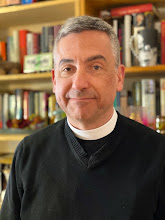“Our Wall of Memory”
One Sunday, not too long after my ordination, I was invited to serve as the guest celebrant and preacher at another church. I was happy to be there, but I find it difficult to preach to people I don’t know, ignorant of their history, customs, and expectations. Preaching from an unfamiliar pulpit, it’s easy to accidentally step on a sensitive spot, causing offense when none was intended. I can’t rely on my “inside jokes.” I can’t use shorthand for themes that I know my parishioners have heard me preach about many times. So, partly because I was nervous and partly because I’m just this way, that morning I arrived at the church much earlier than was necessary. This gave me plenty of time to familiarize myself with the space, get everything set up, and to chat with parishioners as they arrived.
While waiting to start the service, I spent a few minutes looking at the many historical photos that lined a long hallway that led to the parish hall. The first images on this “wall of memory” were from the church’s founding back in the nineteenth century, and then, as I made my way down the hall, the photos moved through the changing styles of the twentieth century. It was interesting to see the pious expressions of the clergy, and touching to see all the joyful and proud faces of parishioners gathered for significant events in the life of the church or posing for annual “class photos” of the choir.
And then, sometime in the 1990s, the photos stopped. I looked to see if the gallery continued around the corner, but there was nothing.
What happened?
I would guess that this wall of memory fell victim to declining membership, or the loss of the one or two parishioners who took an interest in archiving church history, or maybe the arrival of a priest not so interested in the past. Whatever happened, the sad truth is that this particular church is far from unique. To use St. Paul’s as an example, it would probably be easier for me to learn details about what happened here in the 1890s than it would be to find out what was going on in the 1990s. We have a fairly detailed history of the church’s first 100 years and a brief addendum written fifty years later. Still, much of our relatively recent past is already growing hazy in the memories of longtime parishioners – and it’s getting foggy in my memory, too!
Having created detailed ministry plans over the past decade, the Incarnation “side of the family” has a somewhat better grasp of its history. Yet, the recent deaths of Eugenia Suthern and Sidney King have meant an incalculable loss of institutional memory. Over the past seven years, I was part of many conversations when Sidney would passionately (and in great detail) tell the Episcopal Church’s somewhat checkered history in Jersey City. Some of us know that story in broad strokes, but today I could kick myself for not paying even closer attention, taking detailed notes, or even recording him.
In recent weeks, Bishop Hughes has spoken about the vast amounts of our diocesan story that we simply do not know. This institutional amnesia is probably true for many of our churches, but it seems to be particularly true of traditionally Black churches. Perhaps, these communities were too busy fighting for survival to spend much time collecting and preserving history. And, when those churches have closed, and the last parishioners have dispersed, the story is lost. Or, maybe the story is just too painful to recall.
Of course, even seemingly forgotten stories can still echo through generations in surprisingly powerful ways.
If we are to continue stepping into a healthy and honest future, we must know our story, celebrating our blessings and achievements while also acknowledging our errors and failures. This strange and unsettling time might be just the moment for us to fill in as many of the blank spaces of our individual and collective memories as we can. Rev. Laurie and I have begun investigating the best ways to gather, share, and preserve our memories. We’ll have more to say about this project, but for now, I hope you’ll take some time to think about your part in the story of our church, to imagine your place on our “wall of memory.”




